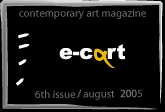| |
|
||||||||||||||||
| |
 |
 |
|
||||||||||||||
 |
|
 |
|
||||||||||||||
 |
|
||||||||||||||||
 |
|
||||||||||||||||
 |
 |
 |
|
||||||||||||||
 |
 |
|
 |
|
|||||||||||||
| |
 |
|
 |
|
 |
|
|
|
|||||||||
| |
|
||||||||||||||||
| |
|
||||||||||||||||
 |
|
||||||||||||||||
 |
|
||||||||||||||||
 |
|
||||||||||||||||
 |
 |
 |
|
||||||||||||||
 |
|
||||||||||||||||
 |
|
||||||||||||||||
| |
|
|
|
|
|
|
|
|
|
|
|
|
|
|
|
|
|
THE OBJECTIVES OF THE OBJECT
an interview with Tino Sehgal by Silvia Sgualdini
SS: How much time have we got?
TS: As much time as you need...
SS: I would like to start by talking about your exhibition at the ICA in London. It is the first of a series of three solo shows at the ICA over a three-year period. This is quite an unconventional way for an institution to present the work of an artist. Is it to do with the unique nature of your practice? How did the structure of the shows develop?
TS: It was Jens Hoffmann's decision, but I don't know why he made it. I think it's because he likes the work or he thinks it is interesting maybe just to follow the work over a certain period of time, but I don't think that there is some inherent connection with the nature of my work.
SS: You didn't discuss this?
TS: No, I wasn't sure if it was true until the moment the ICA announced it in public.
SS: You have worked with Jens Hoffmann on several occasions. Was your first collaboration in 2001 on the exhibition A Little Bit of History Repeated in Kunst-Werke, Berlin?
TS: No, but it was that same year when he invited me to the Tirana Biennale. That was the first thing we did.
SS: How did you meet?
TS: Jens saw this piece I did called 20 minutes for the 20th Century, which is me dancing in 20 dance aesthetics of the 20th Century naked, kind of my body becoming a museum. He saw it at the Moderna Museet in Stockholm in the auditorium and he thought it had a lot to do with another conception of the museum. By that time I had already done my first work, which is what is on show now, so that's how we got into a discussion.
SS: You have a background in choreography and political economy. How did you start working in the field of visual art?
TS: I always wanted to work in art, but it was just not easy to be an artist who does not produce any objects, so I had to find my way somehow. I knew that I wanted to work with singing and the spoken word because I found that their mode of producing - transforming actions - was politically interesting. I wanted to invest in these media on a craftsmanship level so that I could deal with them. But it was also clear to me that I wanted to enter into a tradition of visual art and its discourses. In practical terms, it started at S.M.A.K. Gent, when I showed the work that is now in the Lower Gallery here at the ICA. It was a very local thing, they asked a group I was part of if we wanted to do something. Then, having done a piece made a big difference. My whole thinking was around visual art being a celebration of production and, in my view, quite a reactionary celebration of material production. For me just to put something in the museum that was not a material object was quite a political act, and my first piece was just that. I didn't think of myself as an artist but when the reactions of the people were really quite strong, I realized they were experiencing exactly what the work is about. They were shocked that this was not an object. Some people even thought it was a puppet or a robot. It was very strange. So I was motivated even more than before to keep on going, since I felt that I had found a form which can produce an experience which has something to do with the point of the work and not just talk about a certain point.
SS: The exhibition at the ICA features exactly this piece Instead of allowing some thing to rise up to your face dancing with bruce and dan and other things (2000), which references the video-work of American artists Bruce Nauman and Dan Graham. Could you briefly describe the work and how you see it in relation to the practice of these artists?
TS: On the one hand it is a critique of these artists, on the other hand it is continuing a game that Dan Graham played. Bruce Nauman was influenced by the Judson Church Dance group, you know, and Dan Graham was also... well, Dan Graham is another story. Bruce Nauman put himself in the studio, turned the camera on and eventually brought his videos into the museum. From a certain perspective, he was importing the aesthetic of Judson Church into the museum via video. All this is totally fine of course, but from my point of view and from my interest in things like the spoken word or singing or dance, he kind of lost the decisive thing on the way, which is how they produce - this simultaneity of production and de-production. You do a movement and then it's gone. You say a word and then it's gone. This is exactly what Nauman lost on the way because he made the work into a material fixation. Then Dan Graham took the game further by saying: "Yes, Nauman is interesting but he never reflects the use of the camera. I am going to redo his work but integrate the camera into the work so that you can actually see the camera." If this was a game that one could play, I was going to do the same thing again, but take out the material support, the video screen and the video player. To maintain the simultaneity of production and de-production which they were losing in their import, I would have the person immediately there in the space. On the other hand, I wanted to acknowledge that bringing something like movement into the museum had already happened. My point was to do this import again but in a decisive other way. Of course, one only understands these references through the title. I think the piece works on a more general level: you see this person, in a mise en scène, in a way like an object, but you know it is not an object. So the viewer is constantly asking: "I am looking at this, objectifying this person, because the museum is the place of objectification. It is staged like an object, but it is not an object. And how can I deal with this? What is the difference between the two?"
SS: What kind of reaction do you expect from the viewer?
TS: I think that people negotiate the work in different ways. "Is it an object or not?" If they are sure that it is not an object, lots of people think: "Oh, he is sick and fallen over!" That still happens after five years of showing the piece. It still happens. There was one guy today running and saying: "How can you be standing here?" to the people in the box office, "don't you see that this man is in despair?" He couldn't categorise a person lying there as art, because the definition of art is a material object. These kind of slippages happen a lot and to different degrees. I think they are interesting because something breaks into the discourse of what art is when it cannot be categorised as art but will be categorised as a person who is sick. You have to categorise it somehow, because obviously your eyes are telling you: "I have seen something", and your brain has to say: "what is this something?"
SS: In a way you play with this ambiguity. Here at the ICA the exhibition is mentioned in the program, but once you enter the gallery there is no press release, there is no label that tells you what you are seeing. When someone walks into the gallery, if they are not familiar with your work, they don't know what to expect and what to make of a person lying on the floor.
TS: I don't think so. First of all, the work has a label. A really classical label on the wall. It is my only work that has a label.
SS: Is there? In the gallery? I didn't see it!
TS: I don't think it would make a big difference. If the exhibition was announced on the wall, people would still have the same approach to it.
SS: I think it works much better without an announcement or press release because the work is more subtle. It plays with an element of surprise...
TS: I agree, but on the other hand there is a text in the program of the ICA, so in a way it is like a press release, it is just not a sheet. You also have to consider that, here at the ICA, most people pass the Lower Gallery for the restaurant. They don't care if there is a press release or not or of it says 'Tino Sehgal' on the wall or not. They just walk past. Today this business guy asked: "Is this art?", then he looked for half a minute and went to have his lunch.
SS: You mentioned movement in relation to this piece. For the group show A Little Bit of History Repeated, young artists were invited to reinterpret or elaborate on past works of performance art. The piece you presented related to the work I am Making Art by John Baldessari, in which the artist uses body movements reminiscent of Bruce Nauman's video work, while continuously repeating the words 'I am making art'. Why did you choose this piece by Baldessari as a starting point for your work in that instance?
TS: It was Jens' concept to have one younger artist doing something in relation to an older work. My piece existed before. It is the work I mentioned, where I become a museum of dance for one hour. I started working on the piece in 1999, this was 2001, so it had existed already for two years. I really liked John Baldessari's I am Making Art. Although he is on video - which poses for me the same problems I mentioned with Bruce Nauman - somehow I like the Duchampian 'this is art' transforming into 'I am making art'. There is a strong relation to my approach - the idea of someone making art by transforming their actions - although I would prefer it to be something maybe without an I. A motto for me would maybe be 'they are making art' or something like that. With this in mind, Jens proposed that I could show my piece in relation to that of Baldessari and I wrote a text about it for the catalogue.
SS: Why did you choose to use this piece again for this project?
TS: I think that my piece was a lot about 'I am making art.' It was not about showing different dance aesthetics, it was about how meaning or art can be produced through other means than just making an object. But it was also a kind of crossing out. I mean, I was crossing myself out because I was acting out every possible aesthetic so that, at the end, you couldn't say what the content of the piece was because it had every kind of content and you couldn't say what the form of the piece was because it had somehow every kind of form. So the only thing you could say is that I was using a medium, which involved moving and speaking. I think 'I am making art' is actually more appropriate to my work than Baldessari's, because of the immediacy of doing it in that very moment, whereas he was making art, in that moment, then, when he did the video.
SS: At that time would you have related your work to performance at all?
TS: No, never.
SS: So what would you say is the core of your work?
TS: For me it is like an experiment with myself. How can I produce something, which is in a way something and nothing at the same time, and how can I produce an income out of that. The big question of our times is that I have to produce an income, like everybody else has to produce an income, in order to buy food and housing. But actually there is nothing which is really necessary - except what, say, 5 % of the population are producing in terms of housing and food. If the rest of production is unnecessary as well as problematic for other people in the world or other people in the future, but I still need to produce something to have an income, how can I turn this equation, i.e. just produce something that is somehow also nothing and make an income out of it. By that also mediate or reiterate this whole problem. Today we have enough material products to the point that they are becoming counterproductive, but we still need to produce things because we need an income. So what else could we produce? And are these things then interesting? I think the experimental side of my work is that I produce things which fulfill certain criteria, for example the criteria of being sustainable. But then the question is are they attractive or are they just boring?
SS: Your work deals directly with the problematics of economic production. Currently, other artists are questioning this in a different way, signaling the shift from an economy of production of goods to a service-based economy. In your case, the question is different because you don't acknowledge this shift, you are trying to work on the object itself and its dematerialisation.
TS: I think that the notion of the object is interesting as a cultural technique. We need to have objects. There is no social encounter tout court, we are always encountering each other via an object. Now we are talking about my work so the work is an object, and as soon as we go out of this room, you will know more about me and I will know more about you. There is an object we are creating, which is my work, and now we are centering around it, we are communicating around it. I think objects are quite necessary as a cultural construction to enable a social encounter.
SS: Do you think social encounters are always mediated by the presence of an object around them?
TS: Yes, not necessarily a material object though. We are always talking about something. If I ask you who you are, I am talking about your personality, but your personality is something we construct as an object. What is your personality? I construct your personality as an object and you construct your personality as an object. Then you are there with your personality speaking about your personality. We are constantly creating objects. The decisive question is how they are produced, of which order they are.
SS: I would like to relate the dematerialisation of the object to practices in the late 60s and early 70s, when conceptual art and performance replaced the art object by process or action. This signaled a desire to resist the commodification of the art object by bringing it out of the circuit of the market. In your work, there is a strong awareness of the relation of visual art to the capitalist economy of production, but you don't seem to take a position against it.
TS: No, I take a position for it! That is what people have trouble understanding, because they can't believe that this is the case. I think that the practices you mentioned were quite naïve concerning this point, since you are part of the market economy not by fate, but by decision. Even if it is not a conscious decision, every one of us makes the choice between being autonomous in supplying oneself with necessary food and housing, or producing something else, which can in turn be exchanged for that. The very moment you decide for the latter you are in the market. How you are in the market is something different. To regard that the sole objective in life is to sell as much as possible to as many people as possible is a cultural assumption. I think that the work of the generation you mentioned was a bit naïve, since it was obvious that they were totally inside of the market. Then the fact that they claimed they wanted to be outside of it, didn't really make any difference to the way things were on a hard-fact level. In the end, there were still material artworks, which were produced and sold. I think it is necessary to recognise that you are inside the market to take care of the parameters at play and of how you want to deal with these parameters. How to deal with these parameters is also something you can define. Exchanging is a fundamental thing we do, I don't see any problem with it. The problem is that we have certain cultural assumptions on how we think one should use the market. Yesterday at the Goethe-Institut talk, someone asked me: "Well, why do you sell your work? Apart from the obvious reason that you want to become rich." No, I don't want to become rich. It is not really interesting. I don't believe that to have a higher income will necessarily make me a happier person. It is not the only value in life. To think the higher your income, the better your life is, is just culture. Today people tend to over-emphasise market economy. There is no problem with exchanging things. The question is what one exchanges, how one exchanges and how much time one spends exchanging things. It is not that interesting, it's just a tool.
SS: There is a difference between an economy based on exchange and the capitalist economy of production.
TS: I think this would require a larger frame than this interview can provide, but I think there is no categorical difference. What you call profit is the exchange value people get for the time, energy, risk etc. they invested into a certain project. How high this exchange value is depends not only on the production costs, but also on how important it is for a buyer to have a specific product. To say that products in themselves have a certain fixed value is to adhere to a kind of essentialism. My position would be on the other side, of a performative constructivism. To pursue ones life trying to make as much profit as possible or, as a consumer, making the lowest price the only criteria for buying a certain product are just cultural attitudes. They can certainly exist within markets, but they are not structurally inherent to market economies.
SS: How does your work exist then, if not in the here and now when it's been enacted? How does it function when it is sold?
TS: People can acquire the piece and have the right to show it forever, if they want. Of course they have to employ interpreters to enact the work. I mean, no museum is doing this at the moment but some have said they want to, so let's see what happens.
SS: So, your work has been bought by private collectors, or also by public institutions?
TS: Both. SS: It is quite a difficult type of work to own!
TS: Private collectors also have to enact the work themselves. They really go from having something to being something, which I think it is quite an interesting step.
SS: Going back to the show at the ICA, your first piece is presented together with your most recent installation, which is This objective of that object (2004). The exhibition was conceived as an introduction to your practice and shows its development. How do you say your work has evolved during these years?
TS: In Instead of allowing... I was trying to fulfill all conventions to make my work comparable to a traditional sculpture. There is a person, who kind of looks like an object but it is not an object. From there on I just wanted to become more specific to my own medium. I have people enacting my work and they can become much more than just a solid material can. I just tried to be more media specific. I create situations which use the capacities of these people, and make them increasingly more complex.
SS: In this particular piece you have five interpreters and then the viewer plays a part in it. Can you explain how the piece works?
TS: Basically, there is a kind of prologue, which seduces the viewer into saying something. If they do say something the piece reacts and says: "We have a comment! We have a comment! Who will answer? Who will answer?" The interpreters judge the viewer's comment or speak about it much in the same way the viewer would judge or speak about an artwork, or a critic would speak or write about an artwork. SS: The viewer is invited to have a reaction but, once he/she responds to the piece, the fact that this evolves by itself excludes the viewer. This works, for me at least, to reaffirm that this piece is more like an object than, say, a performance. TS: I am not sure...
SS: In a way you find yourself being commented upon. Even if you try to intervene again, you cannot become part of the discussion. The interpreters discuss something that you initiated, but through their body language of turning their backs to you, shutting you out and simultaneously not allowing you to walk away they exclude you...
TS: This is their decision, it is not mine. Once you make a second comment, they can speak with you. They can speak with you but they don't have to. I prefer when they speak with the people but I leave it up to them to speak about or to speak with.
SS: So, there are two possibilities.
TS: Yes, two possibilities. So, you could try to go back and say something different and possibly they will start talking with you...maybe you just said something they didn't like.
SS: They were talking about it for a long time, but not with me...
TS: What did you say?
SS: What did I say? Oh, I forgot! First, I asked whether we could have a discussion. I said we and they started bouncing off of one another discussing what a discussion is and talking about novels and all kind of interactions. Then some other people came in the room, but they didn't say anything so the piece collapsed on its own, because there was no reaction. When the interpreters were on the floor I said: "Can we still speak when you are lying on the floor?" They livened up again and they started to discuss speech and the difference between the written word as something lying down and the spoken word as something standing up! I thought this was really funny, but when I tried to say something again... I realized... I think it is a type of role-play. When the interpreters get to know one another it becomes very much like a game. They start running this circle of discussion and somehow you can feel that there is a sort of conspiracy between them and that doesn't really include the viewer.
TS: I prefer when they include the people a little, but I leave it up to them to decide. It is their decision and not mine and the fact that it is their decision is part of the work somehow. I like when the viewer becomes ontologically the same as the players, so you can also make your own comment the object of a discussion, i.e. comment upon it. When I showed the work in Cologne, they were almost not speaking about but only speaking with. I guess, here at the ICA, I rehearsed them to speaking about maybe a bit too much and now they are really quite violent. I said to them: "You are violent when you do it", but they are on track and they are going for it. This is fine by me. But maybe it has also something to do with the acoustics.
SS: I think it is a very interesting piece... Yes it is violent because I have noticed other people leaving quite terrified! I like that the interpreters are wearing their own clothes and they could be, or be mimicking other visitors. As you walk in, though, the piece starts again from the beginning, so there is really no mistake that they could be visitors.
TS: Some visitors have been asked: "Are you also part of the piece?"
SS: "Yes, I am going home. I just finished..."
SS: In this later piece you seem to take the process a step further. You employ as artistic tools elements of the theatre, such as the gesture, the human voice, language and role-play. Although there is no stage to separate the viewer from the interpreters, by working with the interpreters through rehearsals and improvisation, your role is becoming similar to that of the theatre director.
TS: Well, I think this is more related to composition, specifically to pieces like John Zorn's Cobra, where the interpreters of the piece can decide upon the composition. Also Xavier Le Roy's piece Project, where the dancers are creating the piece while they are doing it. I think that in theatre, as we know it, you will find very little of this. Then, of course I always use these traditional media in all my works. I mean, this craftsmanship totally comes from choreography or singing or the spoken word. I think that an artist assembles meaning just as a director assembles meaning. There is no kind of categorical difference between what a film director does or and what a visual artist does. They are both creating meaning. That they are working in these different media makes of course a big, big difference in terms of meaning.
SS: In this piece is you allow the interpreters the freedom to bring their own experience into the work, not just their personal voice or their own personal movement but their personal thinking and background as well. They are creating the piece but at the same time they have a set of rules around them, like in a game. So they are not totally inventing the piece...
TS: Yes, it is a sort of game. They are playing a game and that has a certain development. It starts somewhere and the viewer is part of this game.
SS: What's your favorite game?
TS: What is my favorite game? Probably football!
SS: Really? No strategic games?
TS: Well, It is a strategic game!
SS: I want to ask you something about the relationship of your work to the context it is shown in. Specifically, the context of the institutional space of the museum or the gallery. By treating your works as immaterial objects of art you challenge the museological context of the museum. In previous pieces you actually turned elements of the museum such as the press release or the museum guards themselves into the material of your work. How do you see your work in relation to the museum?
TS: I am introducing something into the museum that is somehow its opposite, that is a kind of oral tradition. I just use existing points of the framework of the museum to insert it. If my idea is to have somebody doing something for the entire duration of an exhibition, as a work of art, then I have to realise that there is already somebody standing there for the entire duration of the exhibition. That is the guard and the guard is an interesting figure, because it is the person who watches over objects. The material objects are creating meaning, while the guard doesn't create meaning. It is a strange relationship - in this moment these objects become more important than this person. So, what I did was to put meaning into the guard and say: "what if this person, who is anyway there, creates meaning? What is the difference? What does this imply in terms of how one produces things?"
SS: So, does this challenge the concept of the museum itself as a machine that transmits meaning to future generations?
TS: I think that our idea today is that the library, the museum, the archive transmit knowledge into history. But that is not the case - this is just a small amount. We learn most things from our mother, from the people we grow up with. It is a body to body transmission and this is the most valid transmitter of ideas and values into the future. I want to insert this more important, more valid tradition into the archive.
SS: There is a difference between the museum as transmitter of knowledge and the museum as archive, a recipient of materials or objects from different periods.
TS: In my case this is quite conventional. You can say that the piece This is good is from 2001, Instead of allowing.. is from 2000. You can say that this is what people were interested in 2000, or this is what this guy did in 2000. The cultural values attached to it are cultural values the museum thinks are worth preserving. In that sense it is quite normal. It will never say: "Tino Sehgal, This is Good 2065", it will always say: "Tino Sehgal, This is Good 2001" forever. Time will pass and it will be the same thing, 2001. SS: That is interesting because every time it would be a different incarnation of the work. In 2065, the person interpreting it would be very different from a person interpreting it in 2001. TS: Then there are some interesting points.
SS: I have a last question, which is about the future. This year you have been invited together with Thomas Scheibitz to represent Germany at the Venice Biennale 2005. Can I ask you what we can expect?
TS: Yes, you can because you are working on the project but only when you switch off the machine. So you can, the machine cannot.
SS: So, it's going to be a surprise. I switch this off and we can talk about it. How I do I turn this off?
For information about Tino Sehgal's project at the Venice Biennale, please visit www.labiennale.org